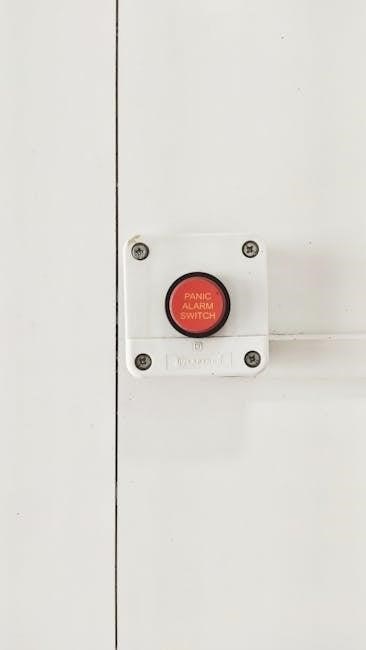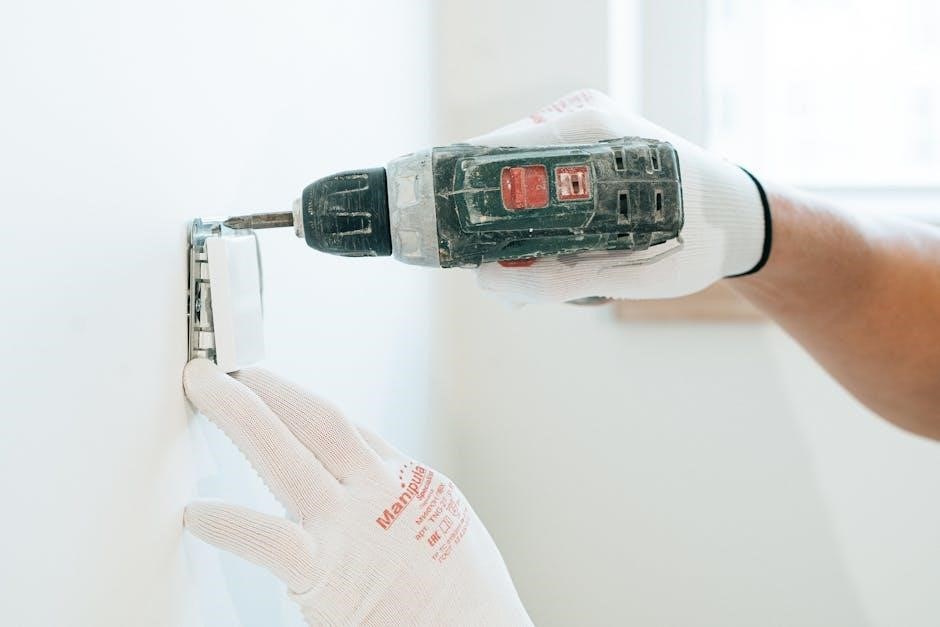PowerFlex 753 Installation Manual: A Comprehensive Guide
This comprehensive guide provides a complete overview, assisting users in mastering the PowerFlex 753 AC drive. It covers installation, operation, and maintenance, ensuring a successful experience. Familiarize yourself with safety precautions, wiring instructions, and applicable codes before beginning installation.
General Precautions and Safety Information
Before installing, configuring, operating, or servicing the PowerFlex 753 drive, it is crucial to thoroughly review this manual and all referenced documentation. Users must familiarize themselves with all applicable codes, laws, and standards, along with the installation and wiring instructions. These drives incorporate integrated safety features, such as Safe Torque-Off and Safe Speed Monitor, that safeguard both equipment and personnel.
Always adhere to general precautions to prevent electrical shock, fire hazards, or equipment damage. Ensure the drive is properly grounded and that all power sources are disconnected before performing any maintenance or modifications. Verify that the drive is installed in a suitable environment, considering factors like temperature, humidity, and altitude.
Pay close attention to warning labels and instructions throughout the installation process. When working with electrical components, use appropriate personal protective equipment (PPE), such as insulated gloves and safety glasses. It’s also critical to understand event, alarm, and problem alerts to effectively troubleshoot and resolve any issues that may arise during operation.
Mounting the Drive
Properly mounting the PowerFlex 753 drive is crucial for its safe and reliable operation. Select a mounting location that provides adequate ventilation and is free from excessive vibration. The drive should be mounted on a stable, vertical surface capable of supporting its weight. Ensure there is sufficient clearance around the drive for proper airflow and access for maintenance.
Follow the mounting dimensions specified in the installation manual to accurately position the mounting holes. Use appropriate hardware, such as screws or bolts, to securely fasten the drive to the mounting surface. It is essential to use all mounting points to distribute the weight evenly and prevent stress on the drive’s enclosure.

Avoid mounting the drive in direct sunlight or near heat sources, as this can affect its performance and lifespan. When mounting multiple drives, maintain adequate spacing between them to prevent overheating. Consider the ambient temperature and humidity of the mounting location to ensure it falls within the drive’s operating specifications. Once mounted, double-check that the drive is firmly secured and level before proceeding with wiring connections.
Power Wiring Connections
Establishing secure and correct power wiring connections is paramount for the PowerFlex 753 drive’s functionality and safety. Before initiating any wiring, always disconnect the main power supply to prevent electrical shock; Consult the drive’s wiring diagram and adhere to all applicable electrical codes and standards. Use appropriately sized and rated wiring for the incoming power supply, considering the drive’s voltage and current requirements.
Carefully strip the wire ends and securely connect them to the designated terminals on the drive’s power terminal block. Ensure that all connections are tight and properly torqued to prevent loose connections, which can lead to overheating or arcing. Pay close attention to the polarity of the connections, especially for DC power supplies.

Grounding is essential for safety and electromagnetic compatibility. Connect the grounding conductor to the designated ground terminal on the drive and ensure it is properly connected to the main grounding system. After completing the power wiring connections, thoroughly inspect all connections to verify they are secure and correctly wired before restoring power to the drive.
Motor Wiring Connections
Connecting the motor to the PowerFlex 753 drive requires careful attention to detail to ensure proper motor operation and prevent damage. Before making any connections, verify the motor’s voltage, current, and horsepower ratings match the drive’s specifications. Consult the motor’s nameplate and the drive’s manual for compatibility information. Use appropriately sized motor leads that meet local electrical codes.
Identify the motor’s phase leads (typically labeled U, V, and W or T1, T2, and T3). Connect these leads to the corresponding motor output terminals on the PowerFlex 753 drive. Ensure that the connections are tight and secure to prevent loose connections, which can cause arcing and overheating. If the motor has a ground lead, connect it to the designated ground terminal on the drive.
After completing the motor wiring connections, double-check all connections to ensure they are correctly wired and securely fastened. Use a torque wrench to tighten the terminal screws to the manufacturer’s specified torque values. Incorrectly wired or loose connections can lead to motor damage or drive malfunction. Finally, perform a motor rotation test to confirm the motor rotates in the correct direction.
Basic I/O Wiring Connections
Establishing basic Input/Output (I/O) connections for the PowerFlex 753 drive involves connecting control signals and feedback devices to the drive’s terminal blocks. Before wiring, review the drive’s I/O configuration and identify the function of each terminal. Common I/O signals include start/stop commands, speed references, and status feedback.

For digital inputs, connect external devices such as pushbuttons, switches, or PLC outputs to the appropriate terminals. Ensure the voltage levels of the external devices match the drive’s input voltage requirements. Use shielded cables to minimize electrical noise and interference, which can disrupt the signals. Connect the shield to the designated ground terminal.
Analog inputs require connecting devices that provide a variable voltage or current signal, such as potentiometers or analog sensors. Wire the signal and ground wires to the designated analog input terminals. For output signals, connect devices such as indicator lights, relays, or PLC inputs to the appropriate output terminals. Ensure the voltage and current ratings of the external devices are compatible with the drive’s output specifications. Verify all connections are secure and properly terminated.
PowerFlex 753 Main Control Board Overview
The PowerFlex 753 main control board serves as the central processing unit of the drive, managing all drive functions, including motor control, I/O processing, and communication. Understanding the layout and components of the main control board is essential for configuration and troubleshooting. The board features a microprocessor that executes the drive’s control algorithms and manages communication with other modules.
Key components include memory modules for storing drive parameters and firmware, communication ports for network connectivity, and I/O interfaces for connecting external devices. The control board monitors the drive’s operating status, including voltage, current, and temperature, and implements protective functions to prevent damage. It also provides interfaces for connecting option modules, such as communication adapters or feedback encoders.
LED indicators on the board display the drive’s status and fault conditions, aiding in diagnostics. Accessing the main control board may require removing the drive’s cover, so follow safety precautions and disconnect power before proceeding. Refer to the drive’s documentation for detailed information on the control board layout, component functions, and troubleshooting procedures.
Option Module Installation (e.g., Communication Network Module)
Installing option modules, such as communication network modules, expands the PowerFlex 753 drive’s capabilities. Ensure the drive is de-energized and disconnected from power before installing any option modules. Refer to the specific module’s installation instructions for detailed steps and safety information.
Locate the designated option module slot on the drive, typically on the main control board or a dedicated expansion area. Carefully align the module’s connector with the slot and firmly press it into place until it clicks or locks. Secure the module with any provided screws or retaining clips.
After installation, configure the drive to recognize and utilize the new module. This may involve setting parameters through the drive’s human-machine interface (HMI) or programming software. Verify the module’s functionality by testing its communication or I/O capabilities. Refer to the drive’s and module’s documentation for parameter settings and troubleshooting information. Improper installation or configuration can lead to drive malfunction or communication errors, so follow instructions carefully.
EMC Plate and Core Installation
The installation of an EMC (Electromagnetic Compatibility) plate and core(s) is crucial for minimizing electromagnetic interference generated by the PowerFlex 753 drive. This helps ensure compliance with EMC regulations and prevents interference with other sensitive electronic equipment. Before commencing, isolate the drive from the main power supply to guarantee safety during the installation process.
Refer to publication 750-IN006, PowerFlex 750-Series EMC Plate and Core(s) Installation Instructions, for detailed, step-by-step guidance. The EMC plate is typically mounted to the drive’s chassis, providing a low-impedance ground connection. Ensure proper contact between the plate and the chassis by cleaning the mounting surfaces. The cores, usually ferrite cores, are installed around the motor and power cables to suppress high-frequency noise.
Position the cores as close as possible to the drive and motor, and securely fasten them. Incorrect installation of the EMC plate and cores can significantly reduce their effectiveness, leading to increased electromagnetic emissions. Always consult the manufacturer’s documentation for specific installation instructions and recommended core types.
Auxiliary Power Supply Installation
The auxiliary power supply (APS) provides a stable and reliable power source for the PowerFlex 753 drive’s control circuitry, even when the main power is disconnected. This ensures the drive can maintain communication, retain parameter settings, and execute safe stopping functions. Before installing the auxiliary power supply, always disconnect the main power to the drive and verify that all capacitors have discharged completely.
Refer to Figure 133 in the manual for the auxiliary power supply installation in PowerFlex 753 drives (all frames) and PowerFlex 755 (frame 1 drives only). Typically, the APS is mounted inside the drive enclosure, often on the upper control pod brackets. Secure the APS using the provided mounting hardware. Connect the APS input to a dedicated power source, ensuring the voltage and current ratings match the APS specifications.
Connect the APS output to the designated terminals on the drive’s control board. Verify the polarity of the connections to prevent damage. Once the APS is installed, power up the drive and verify that the control circuitry is functioning correctly. Proper installation of the APS is crucial for reliable drive operation.
Safe Torque-Off and Safe Speed Monitor Features
The PowerFlex 753 drive incorporates integrated safety features, including Safe Torque-Off (STO) and Safe Speed Monitor (SSM), enhancing personnel and equipment safety. STO immediately removes power to the motor, preventing unexpected starts and allowing for safe maintenance or intervention. SSM monitors the motor speed and triggers a safe state if the speed exceeds a pre-defined limit, preventing hazardous situations.
To utilize STO, connect the safety circuit to the designated STO terminals on the drive. This circuit should be designed according to relevant safety standards, such as IEC 61508 or ISO 13849. Verify the STO function by performing regular tests, ensuring the motor stops immediately when the safety circuit is activated. For SSM, configure the speed monitoring parameters within the drive’s software. Set the maximum permissible speed and the response time for triggering a safe state.
Regularly test the SSM function by simulating overspeed conditions and verifying that the drive initiates a safe stop. These safety features are designed to minimize risks and create a safer working environment.
Troubleshooting: Event, Alarm, and Problem Alerts
The PowerFlex 753 drive features comprehensive diagnostics through event, alarm, and problem alerts, facilitating efficient troubleshooting. Events are informational messages indicating normal operational occurrences. Alarms signal deviations from normal parameters but don’t halt operation, allowing for proactive adjustments. Problems, however, indicate critical faults requiring immediate attention and often trigger a drive trip.
When troubleshooting, begin by examining the drive’s display or connected HMI for active alerts. Record the specific code and description for accurate diagnosis. Consult the PowerFlex 753 documentation for detailed explanations of each alert and recommended corrective actions. Common issues include overvoltage, overcurrent, motor overload, and communication errors. Verify power supply stability, motor connections, and parameter settings.
Utilize the drive’s diagnostic tools to monitor real-time data, aiding in identifying the root cause. If the problem persists, contact Rockwell Automation support for further assistance, providing the recorded alert codes and a description of the observed behavior. Addressing alerts promptly minimizes downtime and ensures optimal drive performance.

Additional Resources: Rockwell Automation Publications
Rockwell Automation offers a wealth of publications to supplement this PowerFlex 753 installation manual, providing in-depth knowledge and guidance. Explore the PowerFlex 750-Series AC Drives Installation Instructions (publication 750-IN001) for detailed recommendations on options port usage and general installation practices. For EMC compliance, refer to the PowerFlex 750-Series EMC Plate and Core(s) Installation Instructions (publication 750-IN006).
To understand wiring and grounding best practices, consult the relevant Rockwell Automation documentation. The “Installation and Maintenance of Solid State Control” (publication SGI-1.1) offers general guidelines for application, installation, and maintenance of solid-state controls.
Further enhance your expertise by exploring publications focusing on specific applications and advanced features of the PowerFlex 753. These resources provide detailed information, diagrams, and examples to optimize drive performance and troubleshoot complex issues. Access these publications through the Rockwell Automation website or authorized distributors. Utilizing these additional resources ensures a comprehensive understanding and successful implementation of your PowerFlex 753 drive system.

